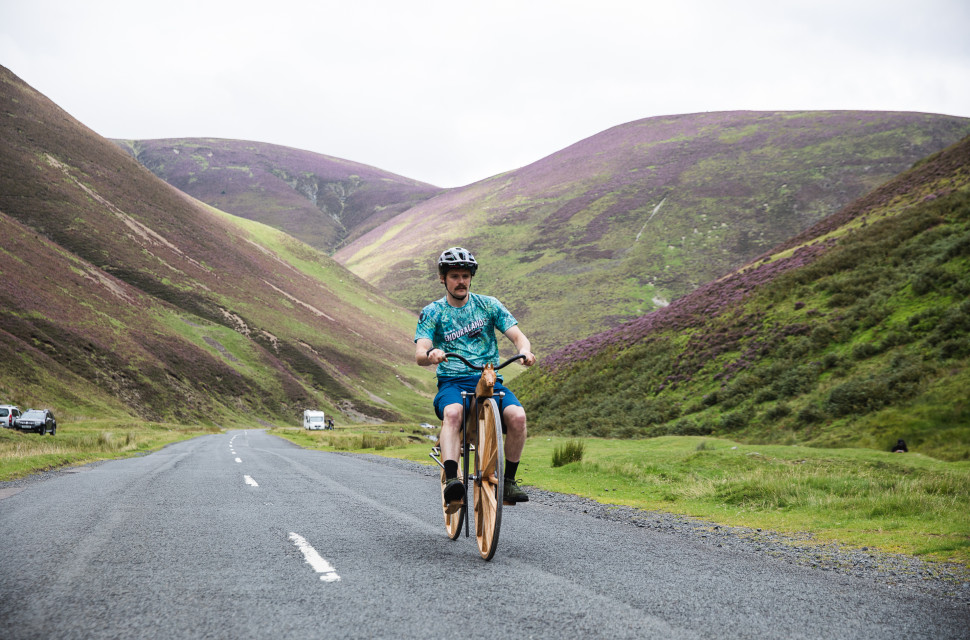Bike check: Kirkpatrick Macmillan's rear-wheel driven wooden replica

After a long day on the roads from Thornhill in southern Scotland, the wooden bike that had been created by Endura for the Forgotten Legend project rumbled across the finish line at Glasgow's Riverside Museum, cheered on by a whole group of supporters on the evening of 10 August. The excitement to see the historical bike was tangible - it is the very recreation of the historical treadle bicycle that Scottish Kirkpatrick Macmillan invented in 1842 - and we had a chance to see the bike in the flesh (and also have a little go riding it).
- Endura revives 19th-century bike for the World Championships
- World Bicycle Relief gives fans opportunity to win World Championship pro bikes
- Preview: 2023 UCI World Mountain Bike Championships
Joining the crew at the Glasgow finish line were Kenny Logan and Ally McCoist who pedalled the historical creation for the last stage of the long day. While completing the 60-mile route from Thornhill to Glasgow would be an easy feat on a modern-day bicycle, it was a whole other ordeal on the 19th-century bike - and some adjustments were made to the original route.
The Endura athletes and supporting group had set off from the southern-Scottish town early on Thursday morning with the intention to track Kirkpatrick Macmillan's route to Glasgow but, instead of rolling the non-paved roads of the 1840s, they had the privilege of traversing 21st-century tarmac roads – and even the smooth tarmac proved tough going on the rigid bike. Among the riders of the bike were Endura athletes and successful mountain bike racers Joe Barnes and Mikayla Parton. They had ridden the bike for miles across the country, visiting the highlights of the re-created route - and by the looks of it, had a blast.
"It was very different, when you first get on it, you just need to forget how to ride a bike," Joe Barnes laughed.
"Cause it's not a circular pedal motion, you push forward with your heels, but once you get into a rhythm it actually goes quite well," he added.
"When I first saw the bike, I was actually quite nervous. We had to adjust the seat height because I could not reach the pedals - but once we did that it was actually great, it works really well. As Joe said, you just need to forget what you know about bikes. But it's been really cool to ride it," Parton echoed.
The bike, that visibly wobbled about every way possible, is something that definitely doesn't exactly inspire confidence - but the athletes said it's what makes this piece of history so captivating.
"Oh I would not change anything about it," Mikayla Parton, an Endura athlete and renowned downhill mountain bike racer, said.
"If it was less wobbly, it would lose its charm!" Barnes exclaimed.
The building process
Bike maker Steven Shand and boat-builder Tim Loftus were the men behind piecing it all together - and were very humble about the creation they'd brought back to life. They had spent hundreds of hours re-creating history and the end result was amazing to see.
The bike operates quite differently from what we are used to now where treadles move the wheel as opposed to crankarms - and you'll notice there is no chain. You sit in a very upright position and there is little room for adjustments or even steering, for that matter.
Shand was responsible for the front load of the project; making sense of the 19th-century drawings, which he said had to be just thought through.
"The design really was already done. We always had to work out how to implement the design, so there were some challenges there. But it was relatively straightforward!" Shand said.
The bike portrays a horse's head at the headtube (if you can call it that) a feature that was included in the original drawings and typical for the bikes of the time, often referred to as the "hobby horses". But unlike Macmillan's bike, hobby horses were scooted forward, not pedalled.
The main frame of the bike is made of ash trees, and the hubs are solid elm with the axle slotted through them. The hub has notches into which the "spokes" slot.
When asked what was the most difficult part of the project for the main builder, Tim Loftus, it didn't take long to form an answer.
"For me, it was the wheels. I've never made a cartwheels before, there are a few tricks and tools that you need before you can make a wheel," Loftus said. He later explained the process was somewhat protected by the olden days wheel builders and definitely is not as easy as it seems. The steel "tyre" on the outside keeps the wheel together, but that ring needs to be formed, and then heated to expand it for fitting around the wooden wheel. As the steel then cools, it shrinks to the right size.
First (and last) ride impressions
After a little convincing from Steven, I did ride the bike myself (although I have no visual proof of that, unfortunately). The unstable, yet rigid, look of it was far from confidence inspiring - and I felt my legs were as wobbly as the bike itself. After I finally got rolling with a push from Steven the bike performed as I expected. As the team members put it, it'd be easier to learn to pedal this bike if you never had ridden a modern bike with circular pedalling motion. The pedals, which Steven said have been made with heeled shoes in mind, also didn't quite fit well with my modern trainers.
The flex of this bike is almost too extensive - it moves in ways I'd say I've never felt a bike move before – kind of like if you had a very out-of-true wheel. The steel-clad wooden wheels make a thunderous rumble on any hard surface. And what of the steering capability? There is barely any. Because of the treadles, the steering axle of the bike is very very narrow, which means that turning it is near impossible without bending the metal treadles. And of course, there are no brakes either.
But man, was it an exhilarating experience to pedal something this historical? Yes. It was indeed like riding a bike for the first time - and there will likely not be another time I can hop on this kind of bike ever again. And I cannot believe someone would've cycled this thing 60 miles.
If you wish to see the recreated Macmillan bike, it will reside at the Dumfries Museum as part of the museum's ongoing “The First Bicycle” exhibition in August.


















1 comments
Please provide convincing evidence, that the story of the invention of the pedal bicycle by K.MacMillan is not a fabrication.
Or else include at the very least a caveat in your article, indicating that the story is at the very least supicious or even untrue.